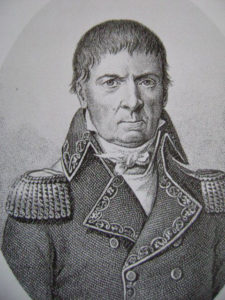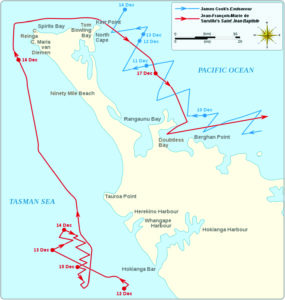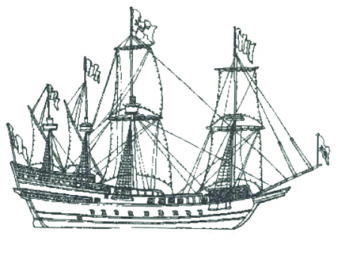From Nieuw-Zeeland to Nouvelle-Zélande

Emeritus Professor John Dunmore
European voyages to New Zealand happened quite late in world history. The Spanish and Portuguese ventured across the Pacific after they had discovered the Americas, and it is not impossible that one or more Spanish galleys reached New Zealand or at least was wrecked in New Zealand waters. There is no solid evidence of this, and in general there was a mistaken belief, which lasted well into the eighteenth century, that the southern half of the Pacific was filled with a large continental mass, the “Terra Australis”.
However, voyages such as those of Abel Tasman, during 1642, showed that there was really a vast expanse of sea between what eventually became known as Australia and New Zealand. Voyages of exploration to settle the question of what lay in southern waters took place in the 1760-1770 period, with the major explorers being the Englishman James Cook and the Frenchman Louis-Antoine de Bougainville.
In 1769, as James Cook explored, among other lands, the coast of New Zealand, another Frenchman, Jean-François-Marie de Surville, also reached New Zealand in his ship, the Saint Jean-Baptiste, a 650-ton ship equipped with 36 guns. He had already made important discoveries in the Solomon Islands, as had Bougainville, but he was still seeking for a reputedly wealthy land called Davis Land. He was, of course, unsuccessful, but came upon New Zealand, and gratefully put into a bay in Northland in order to refit his ship and rest his men, many of whom were affected by dreaded scurvy.

Jean-François-Marie de Surville
Unlike most other expeditions, he included an official chaplain, a friend of his family. The Survilles were pious Bretons, and at the back of their minds, while they held the high hope that the voyage would bring wealth for them and their backers, they felt that the voyage might also help to spread the Good News.

Wikipedia.com
Previously in our written history, the Rev Samuel Marsden has been credited with preaching the first Christian service (as in the hymn, Te Hari Nui) in New Zealand. But more recent research by John Dunmore (1969) and the late Dr Michael King (2003) has brought to light that a Dominican priest conducted the first Christian service in New Zealand, pre-dating Marsden by 44 years.
Fr Paul-Antoine Léonard de Villefeix OP (1728-1780) was born near Étouars in Périgord, France. At the time, it was considered unusual to have a chaplain serving on a commercial ship. In December 1869, the ship arrived in Doubtless Bay and remained for two weeks near Whatuwhiwhi, where Villefeix celebrated the first Mass in New Zealand waters on Christmas Day, 1769. Landing was made at Rangiaohia on the Karikari Peninsula, where Father Villefeix went ashore, unaccompanied by fellow crew members, and visited one of the villages. Villefeix is recorded in the ship’s journal as leading prayers for the sick on Christmas Eve and for eight burials in Doubtless Bay. With nearly half the crew members dying on this voyage, the chaplain was kept very busy consoling the sick and the dying. Unlike his English contemporary, Captain James Cook, the French Captain was not able to combat the often fatal scurvy.
The layover in Doubtless Bay was a brief fifteen days, as continuing gales led to the loss of the ship’s three anchors. The captain did not want to risk further exploration along an unknown coastline. As a ship’s longboat also went missing, Captain Surville blamed local Māori and took a local called Ranginui as hostage.
While press gangs were common at the time in Europe, the practice of enticing natives on board just before departure, termed black-birding, was soon to become common in the Pacific. Many Māori men were recorded in ship journals as “put to work”, then, when sick, were just left behind at far away ports. The Rev Samuel Marsden records finding such unfortunates at English docksides and was kind enough to assist them back to New Zealand.

Saint Jean-Baptiste - Pinterest
The voyage with Fr Paul Villefeix was continued during 1770 across the Pacific towards South America. Before Surville, no European had ever traversed the Southern Ocean from west to east. In April 1770, the Surville expedition reached Peru, where the unfortunate Captain Surville was drowned while trying to land through surf on a beach. Seventeen months later, in 1771, while the Saint Jean-Baptiste was being held by Spanish authorities in Callao, Surville's nephew and Fr Villefeix left the ship to go gold mining up a river. No doubt after such difficult voyages they both deserved a little rest and relaxation, but it seems they were more interested in seeking their El Dorado together.
No one seems to know if their fortunes were made here on earth. However, Fr Villefeix did get back to France eventually, to become parish priest at his home town, Étouars, where he died in 1780, aged a young fifty-two.
 Entries(RSS)
Entries(RSS)